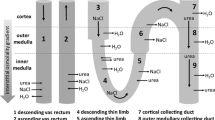Summary
The use of conventional microelectrodes has revealed that the basal membrane potential (Emb) and the transepithelial potential (Tm) inLocusta Malpighian tubules are −39.4 mV and +4.4 mV respectively. No change in Emb was noted after stimulation by diuretic hormone (DH) or cAMP (5 mM), suggesting electroneutral coupling of ions entering the cell.
Intracellular concentrations of potassium and chloride measured by ion selective microelectrodes (ISMs) are 95 mM and 51 mM respectively, and intraluminal potassium measured by direct impalement using ISMs is 139 mM. Luminal sodium and chloride concentrations, measured indirectly, by ISMs in the secreted fluid, are 20 mM and 203 mM respectively in unstimulated tubules.
Using the data for the electrical and chemical gradients it has been possible to speculate how the different ions enter and exitLocusta tubule cells. A hypothetical model has been formulated in which it is suggested that K+ and Na+ can enter across the basal membrane passively but require an energy dependent mechanism to exit across the apical membrane. Conversely Cl− must enter by an energy dependent mechanism but can exit down a favourable electrical gradient.
Similar content being viewed by others
Abbreviations
- Em a :
-
apical membrane potential
- Em b :
-
basal membrane potential
- Tm :
-
transepithelial (transmural) potential
- DH :
-
diuretic hormone
- cAMP :
-
adenosine 3′:5′-cyclic monophosphoric acid
- ISM :
-
ion selective microelectrode
References
Anstee JH, Bell DM, Fathpour H (1979) Fluid and cation secretion by the Malpighian tubules ofLocusta. J Insect Physiol 25:273–380
Anstee JH, Bell DM, Hyde D (1980) Some factors affecting Malpighian tubule fluid secretion and transepithelial potential inLocusta migratoria. Experientia 36:198–199
Berridge MJ, Schlue WR (1978) Ion-selective electrode studies on the effects of 5-hydroxytryptamine on the intracellular level of potassium in an insect salivary gland. J Exp Biol 72:203–216
Diez de los Rios A, De Rose NE, Armstrong W (1981) Cyclic AMP and intracellular ionic activities inNecturus gallbladder. J Membr Biol 63:25–30
Djamgoz MBA, Laming PJ (1981) Intracellular measurement of ionic activity in the nervous system. Trends Neurosci 4:280–283
Frizzell RA, Duffcy ME (1980) Chloride activities in epithelia. Fed Proc 39:2860–2864
Gee JD (1975) Diuresis in the tsetse flyGlossina austeni. J Exp Biol 63:381–390
Gee JD (1976) Active transport of sodium by the Malpighian tubules of the tsetse flyGlossina morsitans. J Exp Biol 64:357–368
Gupta BL, Hall JA, Maddrell SHP, Moreton RB (1976) Distribution of ions in a fluid-transporting epithelium determined by electron-probe X-ray microanalysis. Nature 264: 284–287
Gupta BL, Berridge MJ, Hall TA, Moreton RB (1978) Electron microprobe and ion-selective microelectrode studies of fluid secretion in the salivary glands ofCalliphora. J Exp Biol 72:261–284
Hinke JAM (1969) The construction of pNa and pK microelectrodes for the measurement of aNa and aK in muscle fibres. In: Kerkut GA (ed) Experiments in physiology and biochemistry. Academic Press, London, pp 1–25
House CR (1980) Physiology of invertebrate salivary glands. Biol Rev 55:417–473
Maddrell SHP (1971) The mechanisms of insect excretirt ststems. Adv Insect Physiol 8:199–331
Maddrell SHP (1972) The functioning of insect Malpighian tubules. In: Bolis L, Keynes RD, Wildbrandt W (eds) Role of membranes in secretory processes. North-Holland Press, Amsterdam
Maddrell SHP (1977) Insect Malpighian tubules. In: Gupta BL, Moreton RB, Oschman JL, Wall BJ (eds) Transport of ions and water in animals. Academic Press, London, pp 541–569
Morgan PJ, Mordue W (1981) Stimulated fluid secretion is sodium dependent in the Malpighian tubules ofLocusta migratoria. J Insect Physiol 27:271–279
Petersen OH (1976) Electrophysiology of mammalian gland cells. Physiol Rev 56:535–577
Phillips J (1981) Comparative physiology of insect renal function. Am J Physiol 241:R241-R257
Phillips JE, Mordue W, Meredith J, Spring J (1980) Purification and characteristics of the chloride transport stimulating factor from locust corpora cardiaca: a new peptide. Can J Zool 58:1851–1860
Prince WT, Berridge MJ (1972) The effects of 5-HT and cyclic AMP on the potential profile across isolated salivary glands. J Exp Biol 56:323–334
Ramsay JA (1953) Active transport of potassium by the Malpighian tubules of insects. J Exp Biol 30:358–369
Reuss L, Weinmann SA (1979) Intracellular ionic activities and transmembrane electrochemical potential differences in gallbladder epithelium. J Membr Biol 49:345–362
Stone JV, Mordue W (1980) Adipokinetic hormone. In: Miller TA (ed) Neurohormonal techniques in insects. Springer, New York, pp 31–80
Thomas RC (1978) Ion-sensitive intracellular microelectrodes. How to make and use them. Biological techniques series. Academic Press, London
Zeuthen T (1977) The vertebrate gallbladder — the routes of ion transport. In: Gupta BL, Moreton RB, Oschman JL, Wall BL (eds) Transport of ions and water in animals. Academic Press, London, pp 511–537
Zeuthen T (1980) How to make and use double-barrelled ionselective microelectrodes. In: Bronner F, Kleinzeller A, Boulpaep EL (eds) Cellular mechanism on renal tubule ion transport. Academic Press, New York (Current topics in membranes and transport, vol 13, chap 3, pp 31–47)
Author information
Authors and Affiliations
Rights and permissions
About this article
Cite this article
Morgan, P.J., Mordue, W. Electrochemical gradients acrossLocusta Malpighian tubules. J Comp Physiol B 151, 175–183 (1983). https://doi.org/10.1007/BF00689916
Accepted:
Issue Date:
DOI: https://doi.org/10.1007/BF00689916




